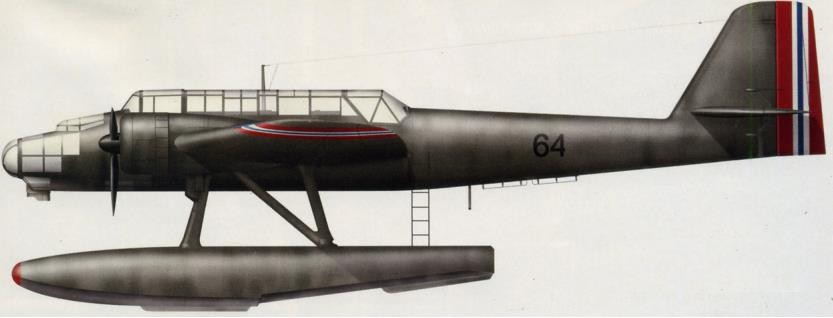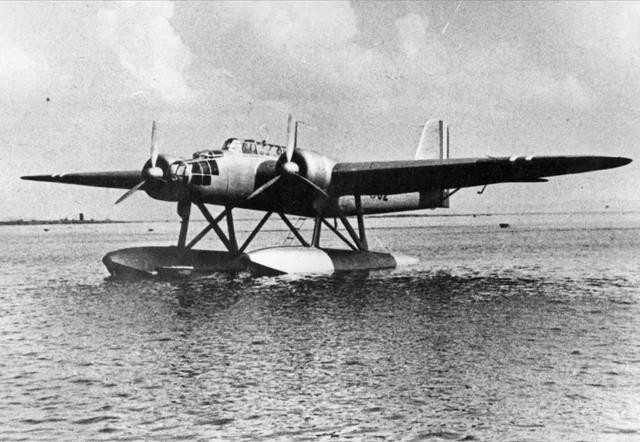Setting several records by the crew of Heinkel He 115V1 in March 1938 aroused interest of the Norwegians. Their naval aviation - the Marinens Flyvapen - required a modem long-
range floatplane. The range was very importan t, considering the Norwegian coastline. In May 1938 initial talks were started, regarding purchase of six float- planes. On 28 August
1938 the Heinkel He 115 contract was signed. The Germans committed themselves to deliver the aircraft between July and November 1939. Price of a single aircraft was RM
275.000 and USS 400. The machines featured some changes with respect to the A-2 series for Sweden.
Defensive armament consisted of two 7.92 mm Colt-Browning M 39 machine guns. This led to redesign of the forward gun post. The Germans removed the rotatable Ikaria GD-A
1114 cupola. The machine gun was mounted in a simple perspex cupola with smaller curvature. Another change affected the forward part of the bomb sight. Aircraft for the Luftwaffe
(A-0 and A-l) the sight was partly covered and protruded outside the fuselage outline. Since the aircraft intended for the Norwegians used the Goertz PZ 1 bomb sights, they did not
need such installation. Behind the cockpit was a loop aerial for the Telefunken FuG III wireless set. The bomb bay was modified to carry an 800 kg 450 mm F.2 torpedo or four 250
kg bombs. The bomb racks were of PVC 1600 type, like in the Luftwaffe aircraft, Norway having purchased German SC250 bombs. Aircraft manufactured for Norway were
designated Heinkel He 115 A-2, although the manufacturer used the designation of Heinkel He 115N-I. The letter "N“ denoted the receiving country, and „I“ meant first series.
All six machines were delivered by air to Norway in 1939. At the same time the Norwegians placed another order for six machines. This was accepted and delivery was scheduled
for April 1940. These aircraft were not delivered. The company retumed the advance payment of 1.65 million crowns that the Norwegians made for the second batch.
Marines Flyfabrik plant at Flörten undertook an attempt to arm the aircraft with a 20 mm Oerlikon cannon. The cannon would be mounted in the forward mount, but the plan was
abandoned. Heinkel He 115A-2 aircraft received the following codes: F-50, F-52, F-54, F-58 and F-60. The machines were allocated to 2. Flyavdeling and 3. Flyavdeling (2nd and
3rd Wing) of the naval aviation. On 9 April 1940 two machines - F-52 and F-58 - were based at Flatoen near Bergen, one - F-60 - was at Hafrsfjord not far from Sola. and three
aircraft - F-50, F-54 and F-56 - were at Skatora near Tromso.
The first to take off at 0415 to combat the German invasion fleet was the crew of Lt. Hans Bugge in F-52. Their task was a reconnaissance of Bergen area, where III Gruppe of the
German fleet operated. This force included cruisers Köln and Königsberg, attacked by the Norwegian crew. The attack was unsuccessfiil due to strong AA fire. After landing at the
base, the crew was ordered at 06.15 to evacuate. F-52 was sent to Norheimsund base at Hafrsfjord, while F-58 was sent to Eivindik. On the first day of the war the Germans
captured the F-60 near Sola. The aircraft was damaged and for that reason the Norwegians failed to evacuate the machine.
During first days of the war the Norwegians lost some of the machines which forced them to re-organise the air assets. Those located in Northern Norway were still unchanged. Of
the aircraft evacuated from Bergen and Oslo areas, the Halogaland Air Group was organised on 11 April 1940 at Lake Vangsmjösa. This included two Heinkel He 115s, used for
reconnaissance missions.
The Heinkel He 115A-2s based at the North were first used against the 3rd Mountain Infantry Division which landed at Narvik. German positions at Laigastind and Gratangseidet
were bombed on 11 April 1940. On 14 April 1940 at V- all three aircraft: F-50. F-54 and F-56 attacked the German airfield at Gullesfjord. Junkers Ju 52/3m transport aircraft were
based there, two of these were destroyed by the Norwegian crews. On 20 April 1940 the crew of F-52 attacked the cruiser Brense. The German warship was hit by a single bomb,
and two more fell close, but none exploded. On 23 April the crew of F-52 evacuated the machine to Sogenfjord. whence combat operations were continued. On 29 April the F-52
took off to bomb German cruisers ät Stavanger, but the crew was forced to tum back due to an engine malfunction.
On 30 April German troops took the Norwegian Navy’s base at Set- nesmoe. The Germans captured several ships. including two large minelayers. The Norwegians decided to
bomb the port. The first attack was carried out by two MF. 11 floatplanes, but without results. Then the F-58 un-dertook a bombing mission, one bomb hitting the Uller minelayer
which sunk immediately.
On 1 May 1940 evacuation of the aircraft commenced. The F-52 flown by Lt. Offerdal flew to Domoch in Scotland. The Heinkel carried two crew-members of the Skua B-24 -
Sub.Lt. Faragut and Mdspmn Ow- bridge who were shot Down on 10 April over Bergen. The other Heinkel He 115 - F-58 - was sent to Tromso on 2 May.
On 14 April 1940 (some sources say 13 April) the Norwegians captured two Heinkel He 115B-1 floatplanes. Both machines belonged to l/Ku.Fl.Gr 106. The German crews
performed reconnaissance of Allied troops in Trondheim - Narvik area. The M2+EH. flown by Lt. z.S. J. Vogler. was forced to alight near Omes due to lack of fuel. Similar fate befell
the crew of Lt.z.S. Beamer. their aircraft coming down at Bronnoysund. Vogler's crew was captured after a combat with local policemen, one of the Germans suffering wounds. The
other crew attempted to hide their aircraft hoping for rapid advance of own ground troops. They were captured. too. and departed the same day on board a Royal Navy vessel to a
PoW camp. Both machines were taken over by the Norwegians, and coded F-62 and F-64. They carried full armament and soon were used in combat. Six Heinkel He 115 (F-50,
F-54, F-56, F-58, F-62 and F-64) floatplanes took part in fighting at Narv ik. On 28 May they flew bombing mission in support of own 7th lnfantry Brigade ad the French 27th Half-
Brigade of the Foreign legion during fighting at Bjervik. which ended in Allied success. German superiority in the air forced the Norwegians to disperse forces. F-62 was based at
Leirvika. The crew was made up of two Norwegian airmen - Lt. Karl August Stanberg and Lt. Alf Strffen Olsen, and an American Donald K. Willis. Willis arrived in Scandinavia at the
beginning of 1940 and joined the Finnish Air Force. Then, when in April Germany invaded Norway, he volunteered for Norwegian Air Force. The crew fought on un- til 8 June 1940.
when the Norwegian armed forces ceased their defence. The crew sunk their aircraft at Tromso.
On 7 and 8 June 1940 evacuation of the aircraft. The first to leave for Britain were three Heinkel He 115s: the F-56, F-58 and F-64. The following day the Heinkel He 115 F-50 flew to
Finland, and the F-54 attempted to fly to Scotland. Due to an engine malfunction it alighted at the Shetlands.



